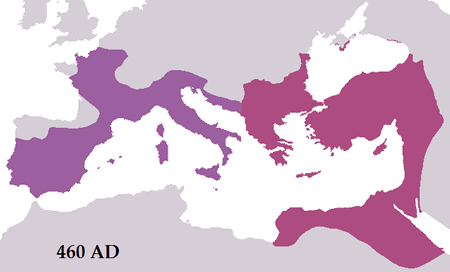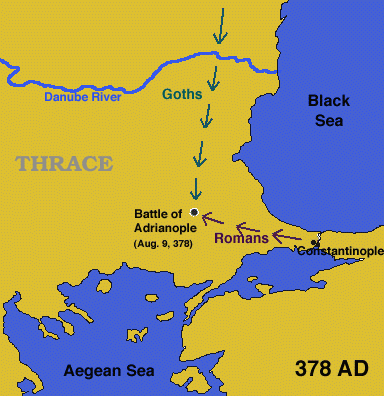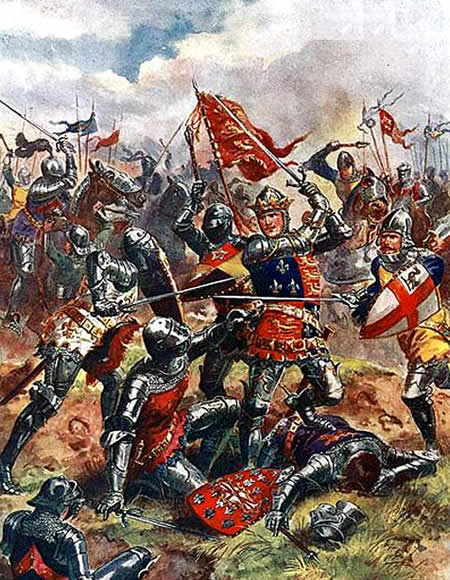 |
| The Grand Duchy of Lithuania |
The Grand Duchy of Lithuania was the last pagan state in Europe. Landlocked and protected by dense forests and impassable wetlands, Lithuania was spared the fate of the other Baltic peoples, who were either converted or killed by German and Scandinavian colonizers between the late 12th and early 14th centuries.
Their geographical location also protected the Lithuanians from Rusian armies and the Golden Horde, who conquered much of eastern Europe in the mid-13th century. Yet Lithuania’s position on the Nemunas River system would also later make it an important economic crossroads in the trade between eastern and western Europe.
During the 14th century Lithuania flourished under a series of able rulers, called “grand dukes,” in imitation of their neighbors to the east, the rulers of Rus. Based out of the ancient (and present) capital of Vilnius, the nascent state began to expand east, into the Rusian lands abandoned by the retreating Tartars. By 1323 they had conquered Kiev, the ancient Rusian capital.
The survival of this pagan state on the frontiers of Christendom deeply disturbed the papacy, which made numerous attempts to convert the Lithuanians. Despite their best efforts, the permanent conversion of Lithuania came not at the instigation of papal legates, but rather at the request of Polish nobles, who offered Grand Duke Jogaila the hand of Queen Jadwiga and the throne of the kingdom of Poland.
In 1386 Grand Duke Jogaila became King Władysław (Ladislas) II of Poland. Lithuania, which had been called the “the spawn of Satan” by Christians in the 13th and 14th centuries, now together with Poland became the “bulwark of Christendom,” defending it first from the Tartars and later from the Ottoman Turks.
The Lithuanian state was the largest in Europe at that time, stretching from the Baltic Sea to the Black Sea. Even after the death of the last member of the dynasty in 1572, the state they had created remained an important player in European politics.
Early Lithuania
The first mention of Lithuania in western sources occurs in an entry in the Annals of Quedlinburg for 1009, which states that the missionary Bishop Bruno of polish “el” Querfurt was martyred there. Historians, however, do not know much about Lithuania before the mid-13th century.
Its geography made it almost impassable for armies in all but the coldest months of winter, which spared it from the first waves of western European expansion along the Baltic littoral, as well as from the territorial ambitions of various Rusian princes and the ravages of the Golden Horde.
Lithuanian society at this time was governed by a loose association of clans based on hill forts, who supported themselves mainly through agriculture, but also through trade and plunder. In the early 13th century power coalesced around the leaders of one of these clans—Ringaudas, whose son, Mindaugas, ruled Lithuania for 25 years (1238–63).
During Mindaugas’s reign he began to take a more active interest in the affairs of his western neighbors. He granted German merchants the right to trade in his lands, and even allied himself with his former enemies, the Teutonic Knights, against western Lithuanians who did not wish to submit to his rule.
This alliance with his German neighbors was symbolized by Mindaugas’s baptism in 1251. Two years later he was crowned by Pope Innocent IV, becoming king of Lithuania. In this same year, Christian, a member of the Teutonic Knights, was enthroned as bishop of Livonia in the new cathedral in Vilnius.
Mindaugas’s conversion however, while a feather in the cap of papal diplomacy, did not have a far-reaching impact on Lithuania for a couple of reasons. First very few of Mindaugas’s subjects followed his example. Second, the new policies that followed his conversion, including allying with the Teutonic Knights, succeeded in further aggravating nobles who were already displeased with Mindaugas’s rule.
In 1259 the frustrated bishop left his seat, and a year later the rebelling western Lithuanians dealt the Teutonic Knights a crushing defeat. The following year Mindaugas apostatized, but some of his subjects were not easily placated. Two years later in 1263, the first great ruler of the Lithuanians was assassinated.
Mindaugas’s death was followed by seven years of civil war, which included the assassination of three of his successors. In 1270 a new ruler emerged, Traidenis, a member of one of the rival clans of Lithuanian nobles. A staunch pagan, Traidenis ruled Lithuania until he died of natural causes in 1282. There is a gap in the historical evidence in the years following his death, but by 1290 a new dynasty emerged that would govern Lithuania (and after 1385 Poland as well) until 1572.
Lithuanians worshiped a pantheon of gods, led by Perkunas, the equivalent of the Scandinavian Thor. The few literary sources describing the religion of the Lithuanians were written by Christians, who often were not neutral observers of pagan practices, which they often tried to fit within the framework of their own belief system. One example of this was the claim made by the Teutonic Knights’ early-14th century chronicler, Peter of Dusburg, that a pagan “pope” led the Lithuanian cult.
Using these sources and other descriptions of Baltic religion and archaeological sources, historians have argued that Lithuanian religion was loosely organized and based on the worship of nature. Priests and priestesses practiced divination both by casting lots and through animal sacrifices.
The brief appearance of Christianity in Vilnius does seem to have had some impact on Lithuanian paganism, as archaeological excavations of Vilnius cathedral have demonstrated that a pagan temple was erected on the site of Mindaugas’s church after his demise.
The ostensible leader of the Lithuanian cult was the grand duke, and it appears that rulers after Mindaugas learned that a monumental religious building could be a powerful expression of central authority. The most likely builder of the temple was Gediminas, who reestablished Vilnius as a political capital in the first years of his reign.
Establishment of The Grand Duchy
 |
| The Grand Duchy of Lithuania coat of arms |
The founder of the new dynasty, Pukuveras, did not have a great impact on Lithuania, because of his brief reign (1290–95). During the reigns of his sons, Vytenis (1295–1315) and Gediminas (1315–42), on the other hand, Lithuania would dramatically expand politically, geographically, and economically to become one of the most important states in east-central Europe.
In 1298 during a dispute between the archbishop and burghers of Riga and the Teutonic Knights, Vytenis offered the Rigans a Lithuanian garrison to defend this important commercial center from their common enemy. Although the Rigans were finally compelled to expel the pagan garrison in 1313, diplomatic and economic relations between the Lithuanians and Rigans continued. Gediminas continued these policies when his brother died in 1315.
Gediminas built up the Lithuanian economy, inviting foreigners to settle in villages and towns by sending letters to the numerous German towns. He also granted German merchants generous privileges throughout his realm and guaranteed their safety along certain routes, called the vredelant, or “land of peace.”
Although trade with the pagans was condemned by the papacy, especially the trade of military supplies, commerce prevailed throughout the crusading period, even between the Lithuanians and the Teutonic Knights. In fact trade between these two states helped to finance their wars with each other.
Gediminas was aware of the necessity of forming military alliances with his Catholic neighbors, the Rigans and the Poles, against their common enemy, the Teutonic Knights. But he had to be careful about offending his subjects—the pagan Lithuanians as well as the Orthodox Rusians, who were quickly becoming the majority of those living in the Lithuanian state. The Lithuanians had long taken an active role in the affairs of their Rusian neighbors, and some prominent Lithuanians had been baptized according to the Eastern rite.
For example one of Mindaugas’s sons became an Orthodox monk, eventually becoming the patron saint of Pskov, while another of his sons, Vaisvilkas, also retired to an Orthodox monastery after ruling Lithuania for three years (1264–67). In addition lacking a written culture of their own, Lithuanian rulers used the language of their Orthodox subjects, Chancery Ruthenian, at their courts.
During Gediminas’s reign these contacts intensified. Through a combination of conquest and marriage alliances, Lithuanian rule was extended farther into Rusian lands, as the Lithuanians filled the power vacuum left by the retreating Tartars. By 1323 Gediminas had conquered Kiev, the ancient capital of Rus.
In 1315 Gediminas established a separate metropolitan for Lithuania in Novgorodok, which would free his Orthodox subjects from the ecclesiastic control of a Muscovite metropolitan. During the course of the next century, this Lithuanian metropolitanate would be reduced to the rank of a bishopric and then elevated again as the patriarch of Constantinople sought to manipulate the political landscape of Rus.
 |
| Christianization of Lithuania |
At the same time that he appealed to the head of the Eastern Church, Gediminas was also actively seeking the help of the leader of the Western Church to orchestrate a truce with the Teutonic Knights. The price for this truce would be the conversion of Lithuania.
Gediminas informed Pope John XXII of his intensions in 1322 and joined his longtime allies, the archbishop and burghers of Riga, in condemning the atrocities committed by their common foe, the Teutonic Knights. His letter outlined the history of Lithuania’s relationship with Latin Christianity, noting Mindaugas’s conversion as well as his brothers’ defense of Riga.
When the papal envoys arrived in 1324, however, Gediminas had changed his mind, which led some earlier scholars to argue that his letter to the pope was a Rigan a forgery. Gediminas had been reminded of Mindaugas’s fate by some of his pagan and Orthodox subjects.
When the papal legates departed in 1325, Gediminas looked to the west for a new ally and found King Władysław Lokietek of Poland, who was also involved in a dispute with the Teutonic Knights. In this same year Aldona (baptized Anna), one of Gediminas’s daughters, was married to Władysław’s only son, Casmir (Kazmierz). Although the Polish-Lithuanian alliance dissolved after Anna’s death in 1339, the memory of this union would have a tremendous impact on the destinies of both states.
After Gediminas’s death in 1342, his son, Jaunutis, assumed the grand ducal throne. Despite the fact that he was his father’s chosen heir, his reign was brief (1342–45), because his brother, Algirdas, drove him into exile in Moscow. Grand Duke Algirdas’s reign proved to be lengthy (1345–77), in part because he reconciled his position not only with Jaunutis, to whom he granted land from his patrimony, but also with his six other brothers.
His youngest brother, Kestutis, was his greatest ally, and he was given the important task of defending Lithuania’s western border from the Teutonic Knights. Algirdas continued his father’s kegiatan of expansion into Rus, attacking Moscow and trying to reestablish the metropolitanate for the Lithuanian Rus. He also followed in his father’s footsteps of offering to be baptized—this time to both the pope in Avignon and the patriarch of Constantinople—and then denying these intentions.
Despite these ploys, he, like his father, was tolerant of the Christians who lived in his realm, at least as long as they respected Lithuanian religious practices. Five Franciscans found this out the hard way when they were executed for proselytizing.
When Algirdas died he wanted his throne to pass to his son, Jogaila, but Kestutis challenged his nephew’s succession. In 1381 Kestutis overthrew Jogaila, but the usurper was assassinated a year later. When Jogaila returned to power in 1382, he considered taking a Muscovite princess as his bride in the hope of eventually fulfilling his father’s pretensions to the title of grand prince of All Rus.
The resurgent power of the Tartars, however, signaled by their sack of Moscow in 1382, caused the young grand duke to turn west for a bride, to the kingdom of Poland, with which his grandfather had been allied and which had also just lost its king.
Union with Poland
When King Casimir III the Great of Poland died without a son in 1370, his crown passed to his nephew, Louis of Anjou, king of Hungary. Following his death in 1382, the nobles of the two kingdoms were divided as to who should succeed him. After two years of fighting it was decided that his older daughter, Maria, would succeed him in Hungary, while his younger daughter, Jadwiga, would succeed him in Poland.
In 1384, at the age of 10, Jadwiga was crowned queen. Although she had previously been betrothed to Wilhelm von Habsburg, prince of Austria, the Polish nobles rejected this marriage and instead looked east to pagan Lithuania. This was not such an odd decision, however, considering the historical relationship between the two states, and King Casimir’s first wife was a Lithuanian princess.
When Grand Duke Jogaila accepted Christianity in 1386, which was one of the preconditions of his assuming the throne, he took the Christian name Władysław, the name of Casimir’s father, the ally of his grandfather, Gediminas, and the restorer of the Polish kingdom. The following year Władysław II returned to Vilnius and established a bishopric there to manage his pagan subjects’ conversion to Christianity.
When the childless Jadwiga died in 1399, the Polish-Lithuanian state faced a dilemma. In two important assemblies in 1401 and 1413, the Polish and Lithuanian nobles decided to make the Krevo Union (named after the place in which it was created in 1385) permanent.
In fact, unlike other contemporary mergers of states, such as the Kalmar Union, which united the Scandinavian kingdoms in 1397, the Polish-Lithuanian union would prove to be lasting, even surviving the demise of the Jagiello dynasty (named after the Polish version of Jogaila’s name—Jagiello) in 1572.
Building upon this consensus Wladyslaw II led an army against the perennial enemies of Poland and Lithuania, the Teutonic Knights, dealing them a crushing defeat at the Battle of Grunwald in 1410.
 |
| the Battle of Grunwald in 1410 |
His second son, Casimir IV (his first son, Władysław III, having been killed trying to stop the advance of the Ottoman Turks into Europe at the Battle of Varna in 1444), was a ruler equal to his father, in both ability and longevity—while his father ruled Poland-Lithuania for 45 years (until 1434), Casimir ruled for 48 (until 1492). He also defeated the Teutonic Knights in the Thirteen Years’ War (1454–66) and annexed many of the Knights’ possessions, which had formerly belonged to Poland.
Some scholars have called him “the father of Central Europe,” because his sons ruled the neighboring kingdoms of Bohemia and Hungary in addition to Poland-Lithuania, and his grandson was Albrecht von Hohenzollern, the last grand master of the Teutonic Knights, who secularized the order in 1525 and founded the dynasty that was to rule Prussia (and later Germany) until the end of the First World War. The eminent scholar Jan Dlugosz, who wrote the first comprehensive history of Poland, educated these children.
Casimir’s fourth son, Zygmunt I “the Elder,” as his father and grandfather ruled for more than 40 years (1506–48) and expanded his kingdom at the expense of the Teutonic Knights, who in two stages (1525 and 1561) were incorporated into the kingdom.
His reign, however, was marred by the growing power of his two neighbors to the east—Moscow and the Ottoman Empire. Because of these threats, Zygmunt looked west to the Habsburg empire for aid. In 1515 at the Congress of Vienna, a double wedding was arranged.
Zygmunt’s son, King Louis of Hungary and Bohemia, would marry the emperor’s daughter, while the emperor’s son would marry Zygmunt’s daughter, Anna. Unfortunately for the territorial ambitions of Poland-Lithuania, the childless Louis died trying to defend Hungary from the Ottomans at the Battle of Mohacs in 1526. The Habsburgs now controlled what was left of Hungary as well as Bohemia.
Following this disaster Zygmunt had his son, Zygmunt II August, crowned co-ruler in 1529 at the age of nine. He and his father ruled together for nearly two decades—“the Elder” in Kraków, and Zygmunt II in Vilnius. In the years following his father’s death, the childless and ailing Zygmunt II was anxious to see that his family’s legacy as rulers of a united Polish-Lithuanian state did not end with his death.
Near the end of his life he convened the Sejm (parliament) nearly ever year in an attempt to convince the Polish and Lithuanian nobles to form a united republic, ruled by an elected monarch. On July 1, 1569, the religious and secular magnates of Poland and Lithuania swore to Zygmunt to uphold the Union of Lublin, which combined their two lands. Three years later the last of the Jagiellonians died.
The legacy of the state created by Jogaila, however, would endure long after the demise of his dynasty. The last pagan ruler in Europe had transformed his state into the “bulwark of Christendom,” and several of his descendants gave their lives in its defense. But Poland Lithuania was also a multiethnic and multireligious polity, the survival of which necessitated toleration.
In 1573 the Confederation of Warsaw guaranteed the religious rights of all the subjects of Poland-Lithuania— Catholic, Orthodox, and Protestant Christians, as well as Jews and Muslims. The largest state in Europe at that time, the republic created by Zygmunt II would endure for more than two centuries, until it was finally partitioned among Russia, Prussia, and Austria in the late 18th century.









